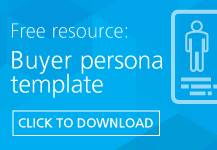sales-marketing-content
How to map content to buyer personas: part 2—build out your personas
A popular (and incredibly effective) trend in marketing and sales recently is to map content to buyer personas. This 5-part blog series will teach you a simple way to create content that directly targets individual buyers, enabling your sales and marketing teams to engage buyers more effectively.
In the first part of our content mapping series, we discussed how to create foundation buyer personas that map to your company’s typical buyers. In this second step, we’ll outline how to go turning personas into something truly useful for your company by:
Building out your personas
Research time!
Just knowing that your buyer is in the IT department isn’t going to do you much good. Take each persona and outline any relevant information. Typical areas for personas include their pain points, critical business issues, strategies, responsibilities, peers and internal issues.
Do some basic research, but it’s okay to do some guesswork too—these should be living documents, constantly updated as new information about buyers becomes clear.
What’s common to your buyers?
A frequent mistake made when creating buyer personas is getting so caught up in creating believable, detailed personas that the end result contains a bunch of information that isn’t applicable half the time. Unless very relevant to your company, avoid specifics like gender, number of children, marital status, etc. Stick with ranges or just omit altogether.
Bad: Your buyer persona is 32 years old
Better: Your buyer persona is 30-50 years old.
Best: Cut out that information altogether unless it’s relevant to your industry.
Instead of trying to cram the traits and expectations of all your past buyers into one persona, keep it simple by focusing on the elements common to ALL your buyers.
What do you really want to know?
Remember that these personas are supposed to be a reference for your sales reps and marketers—if each persona is 5 pages long, your team is not going to read it. A good rule of thumb is that if the information doesn’t offer insight to your team members, cut it.
Is it really useful for your team to know that the buyer likely works 50 hours a week? Or is it more useful to know that case studies and data sheets are the best types of content to send to that buyer? You be the judge.
Use a template
 Cut down on persona creation time by using a template. You can download an editable, Microsoft Word persona template that we’ve created for free here.
Cut down on persona creation time by using a template. You can download an editable, Microsoft Word persona template that we’ve created for free here.
Modify it to fit the fields and topics you feel are most relevant for your company. If possible, always keep your personas to one page (they’re more likely to be used on a regular basis if they’re short).
By this point, you should have a strong foundation for buyer personas, so you’re ready to move on to the content side of things! In our next post, we covered how to do a content audit to see where you can repurpose content and where you need to start from scratch.
See the rest of the series here:
- Part 1: Figure out your audience
- Part 2: Build out your personas
- Part 3: The content audit
- Part 4: Content creation
- Part 5: Tracking content effectiveness











